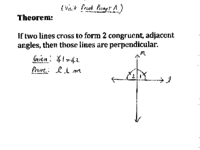
Proof Prompt (A)
[color=#0000ff][b]Theorem: [/b][/color][br][br]If two lines cross to form [color=#9900ff][b]congruent, adjacent angles[/b][/color], then those [b]lines are perpendicular.[/b] [br][br][br]Write a 2-column (or paragraph) proof that formally proves what this applet informally illustrates. [br][i][color=#cc0000]Be sure to set up an appropriate diagram, state what is given, and state what needs to be proven. [br]Then prove it! [/color][/i] [br][br]
Proof Prompt (A)
Triangle Area Action! (V1)
In the applet below, [color=#38761d][b]a triangle is shown[/b][/color]. [br][br]You can change the sizes of the [b][color=#1e84cc]blue angle[/color][/b] and [color=#ff00ff][b]pink angle[/b][/color] by using the sliders in the lower-left corner. You can also move the white points anywhere you'd like at any time. [br][br]Interact with the applet below for a few minutes.[br]Then answer the questions that follow.
Area of a Triangle = ?
1.
In this applet's dynamics, the triangle was transformed into another figure. What kind of figure is it? How does the applet imply your classification is correct?
2.
How does the [b]area of the newer figure[/b] compare with the [b]area of the original triangle[/b]?
3.
How does the [b]BASE [/b]of the newer figure compare with the [b]BASE[/b] of the original triangle?
4.
How does the [color=#9900ff][b]HEIGHT[/b][/color] of the newer figure compare with the [color=#444444][b]HEIGHT[/b][/color] of the original triangle?
5.
Given your responses to (1) - (4) above, describe how you can find the area of [b][color=#38761d]ANY TRIANGLE. [/color][/b]
Quick (Silent) Demo
Parallelogram: Area
Directions:
In the app below, use the [b]filling[/b] slider to make the parallelogram light enough so that you can see the white gridlines through it. [b]But don't touch anything else yet! [/b][br][br]After you set the [b]filling[/b] slider, try to count the number of squares inside this parallelogram. [br]Be sure to include partial squares! Provide a good estimate in the question box below.
Try to count the number of squares inside this parallelogram. How many squares (i.e. square units) do you estimate to be inside this parallelogram?
Slide the "[b]Slide Me" [/b]slider now. Carefully observe what happens. What shape do you see now?
How does the area of this new shape compare with the area of the original parallelogram? How do you know this?
How many squares do you now count in the newer shape that was formed? How many squares were in the original parallelogram?
Without looking it up on another tab in your browser, describe how we can find the area of ANY PARALLELOGRAM.
Congruent Segments Construction (I)
I[color=#000000]n the applet below, use the limited toolbar to construct segments that are congruent to the two segments displayed.[br]Use the [b]Distance[/b] tool afterwards to show that these segments are indeed congruent. [/color]
I[color=#000000]n the applet below, use the limited toolbar to construct segments that are [b]triple the length[/b] of the two segments displayed.[br]Use the [b]Distance[/b] tool afterwards to show that these segments are indeed triple the length of the original segments displayed. [/color]
Equilateral Triangle Construction Template
[color=#000000]In the applet below, use the tools of the limited toolbar to construct an [b]equilateral triangle that's inscribed in the circle shown.[/b] [br][br][i]When you're finished, show that the triangle you've constructed is indeed an equilateral triangle.[/i][/color]
Geometry Resources
[list][*][b][url=https://www.geogebra.org/m/z8nvD94T]Congruence (Volume 1)[/url][/b][/*][*][b][url=https://www.geogebra.org/m/munhXmzx]Congruence (Volume 2)[/url][/b][/*][*][b][url=https://www.geogebra.org/m/dPqv8ACE]Similarity, Right Triangles, Trigonometry[/url][/b][/*][*][b][url=https://www.geogebra.org/m/C7dutQHh]Circles[/url][/b][/*][*][b][url=https://www.geogebra.org/m/K2YbdFk8]Coordinate and Analytic Geometry[/url][/b][/*][*][b][url=https://www.geogebra.org/m/xDNjSjEK]Area, Surface Area, Volume, 3D, Cross Section[/url] [/b][/*][*][b][url=https://www.geogebra.org/m/NjmEPs3t]Proof Challenges[/url] [/b][/*][/list]
What phenomenon is dynamically being illustrated here? (Vertices are moveable.)
What phenomenon is dynamically being illustrated here? (Vertices are moveable.)
Functions Resources
[list][*][b][url=https://www.geogebra.org/m/k6Dvu9f3]Interpreting Functions[/url][/b][/*][*][b][url=https://www.geogebra.org/m/uTddJKRC]Building Functions[/url][/b][/*][*][b][url=https://www.geogebra.org/m/GMvvpwrm]Linear, Quadratic, and Exponential Functions[/url][/b][/*][*][b][url=https://www.geogebra.org/m/aWuJMDas]Trigonometric Functions[/url][/b][/*][/list]
